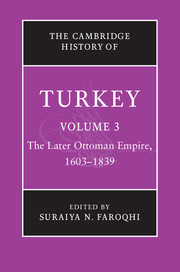Book contents
- Frontmatter
- PART I BACKGROUND
- PART II AN EMPIRE IN TRANSITION
- PART III THE CENTRE AND THE PROVINCES
- PART IV SOCIAL, RELIGIOUS AND POLITICAL GROUPS
- 10 The Ottoman ulema
- 11 Muslim women in the early modern era
- 12 The Ottoman Jews
- 13 Christians in a changing world
- PART V MAKING A LIVING
- PART VI CULTURE AND THE ARTS
- Glossary
- Bibliography
- Index
- References
12 - The Ottoman Jews
from PART IV - SOCIAL, RELIGIOUS AND POLITICAL GROUPS
Published online by Cambridge University Press: 28 March 2008
- Frontmatter
- PART I BACKGROUND
- PART II AN EMPIRE IN TRANSITION
- PART III THE CENTRE AND THE PROVINCES
- PART IV SOCIAL, RELIGIOUS AND POLITICAL GROUPS
- 10 The Ottoman ulema
- 11 Muslim women in the early modern era
- 12 The Ottoman Jews
- 13 Christians in a changing world
- PART V MAKING A LIVING
- PART VI CULTURE AND THE ARTS
- Glossary
- Bibliography
- Index
- References
Summary
The people
In the early seventeenth century, Ottoman Jewry comprised immigrants from the Catholic world as well as members of indigenous communities, which the Ottomans inherited together with the countries they conquered. Some of these countries were Muslim and others were Greek Orthodox. The indigenous Jewish communities of the Muslim world usually spoke Arabic, while those of the Greek Orthodox world were generally Greek speakers. The members of the immigrant communities that grew up in the empire from 1492 on usually spoke a Castilian dialect of Spanish, but also a southern and Sicilian dialect of Italian, as well as Portuguese.
During the seventeenth century, the flow of Jewish refugees from Catholic Europe to the Ottoman Empire came to a virtual standstill. This was because the pool of ‘New Christians’ in Spain and Portugal who still wished to live in ‘a Jewish place’ had dried up. Another, more compelling, reason was the rise in international trade, which led various Catholic countries to suffer the presence of ‘New Christians’ who secretly observed – or openly reverted to – their former Jewish religion, for their commercial contribution. In certain places, such as Leghorn (Livorno) (in 1593), such Jews were even awarded rights very similar to those granted to Christians.
In the late seventeenth and early eighteenth centuries, the globalisation of commerce led to Jewish immigration of another kind; the new immigrants were Jews who held on to the nationality of their Catholic countries of origin and settled in the empire for economic reasons.
- Type
- Chapter
- Information
- The Cambridge History of Turkey , pp. 256 - 271Publisher: Cambridge University PressPrint publication year: 2006
References
- 2
- Cited by



